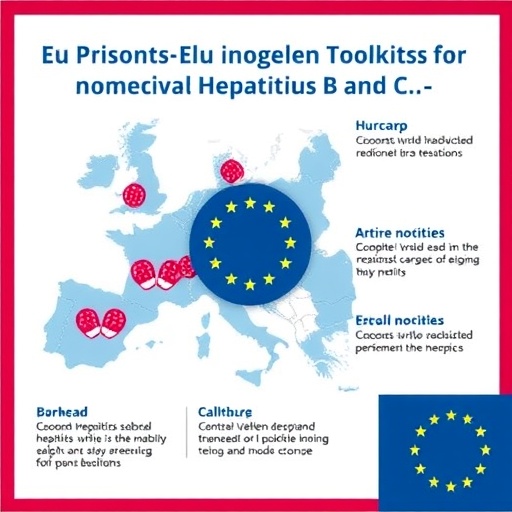A groundbreaking new toolkit has been unveiled by leading European health agencies aimed at eliminating viral hepatitis B and C within prison systems across Europe. This initiative represents one of the most comprehensive efforts to date to address the significant public health challenge posed by viral hepatitis in correctional facilities. By promoting the principle of “equivalence of care,” the toolkit ensures that incarcerated individuals receive healthcare interventions on par with those available to the broader community, tackling both prevention and treatment strategies simultaneously.
Viral hepatitis remains a considerable burden worldwide, and prisons are particularly high-risk environments for transmission of hepatitis B and C viruses. Incarcerated populations experience disproportionately high prevalence rates compared to the general population, in part due to a higher incidence of risk behaviors such as injecting drug use. The sharing of injecting paraphernalia acts as a potent vector for transmission, compounded by other risk factors including unsafe tattooing practices, body piercings, sharing of personal hygiene items like razors, and unprotected sexual activity. These factors collectively make prisons critical focal points for targeted intervention.
One of the challenges in controlling viral hepatitis in prison environments is the nature of incarceration itself: many inmates serve short sentences or cycle repeatedly through the system. This movement between community and custody presents unique opportunities but also challenges for public health. Interruptions in care and follow-up can lead to treatment failures and ongoing transmission. However, by effectively addressing hepatitis within prisons, the ripple effect extends beyond correctional walls, contributing to the reduction of viral hepatitis transmission in the general population — a phenomenon known as the “community dividend.”
The toolkit has been meticulously developed by the European Union Drug Addiction (EUDA) and the European Centre for Disease Prevention and Control (ECDC). It encompasses four distinct yet interrelated sections: background information outlining the epidemiology and challenges; guidance on strategy development tailored to prison settings; practical steps and tools for implementing those strategies; and methodologies for monitoring and evaluating intervention effectiveness. This resource equips prison healthcare providers and policymakers with evidence-based frameworks for concerted elimination efforts.
Practical implementation considerations are a cornerstone of the toolkit. Beyond theoretical strategy, the resource provides access to a variety of aids such as context assessment templates, diagnostic algorithm recommendations, and frameworks for integrating hepatitis screening and treatment services into existing prison health infrastructures. These tools help institutions tailor approaches to their unique epidemiological and operational circumstances, increasing the likelihood of successful intervention.
The impact of this toolkit is not limited to healthcare professionals within prisons alone. Its design implicitly recognizes the complex ecosystem of prison life, involving security staff, peer support workers, and even the inmates themselves as pivotal actors in the prevention and treatment landscape. Increasingly, prisoners are mobilized as agents of change, facilitating peer-led education and support networks that enhance engagement and adherence to treatment schemes.
In addition to the robust content of the toolkit, EUDA and ECDC are committed to providing ongoing support via dedicated training programs for prison healthcare workers. Through interactive sessions and capacity-building initiatives, these agencies aim to bolster knowledge and skills necessary to operationalize hepatitis elimination strategies effectively. This training component ensures that the toolkit is not merely a static document but a dynamic instrument driving real-world results.
European countries such as Germany, Spain, France, Italy, and Luxembourg feature prominently in the toolkit as examples of best practices. These models illustrate diverse approaches to hepatitis care in prisons, showcasing how interventions can be seamlessly integrated into routine health services while respecting prisoners’ rights and security concerns. The resulting case studies underscore the feasibility and effectiveness of targeted elimination programs, even within the constraints of correctional environments.
The public health implications of this initiative cannot be overstated. Controlling viral hepatitis in prisons addresses a population that has traditionally been underserved and at heightened risk, thereby reducing overall disease burden and health inequities. Moreover, by halting chains of transmission within custodial settings, these efforts contribute significantly to broader continental goals for viral hepatitis elimination, aligned with WHO directives and sustainable health strategies.
From a virological standpoint, hepatitis B and C viruses represent persistent pathogens that evade immune clearance and cause chronic infections leading to serious liver diseases including cirrhosis and hepatocellular carcinoma. Introduction of direct-acting antiviral agents (DAAs) for hepatitis C and effective antiviral therapies for hepatitis B have revolutionized treatment prospects. Yet, without systematic identification and consistent treatment adherence, elimination remains elusive—particularly in populations with high turnover and complex social dynamics such as incarcerated individuals.
Finally, the launch of this European toolkit stands as a testament to the increasing recognition of prisons as critical sites for infectious disease control. It pushes forward the agenda that health is a fundamental right regardless of legal status and that equivalence of care is indispensable for achieving public health milestones. Through this collaborative and integrative approach, the entrenched challenges of viral hepatitis in prisons are poised to be overcome, benefiting millions and marking a significant victory for public health equity.
Subject of Research: Viral hepatitis B and C elimination strategies in European prison systems
Article Title: New European toolkit launched by EU agencies to help eliminate viral hepatitis B and C in prisons
News Publication Date: 6-Aug-2025
Web References: https://eurohepp.ecdc.europa.eu/
COI Statement: None declared.
Keywords: Viral Hepatitis, Hepatitis B, Hepatitis C, Public Health, Imprisonment, Infectious Disease Control, Prison Healthcare, Disease Elimination, European Union Drug Addiction (EUDA), European Centre for Disease Prevention and Control (ECDC)




